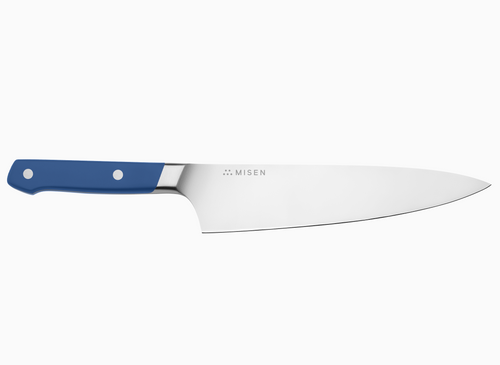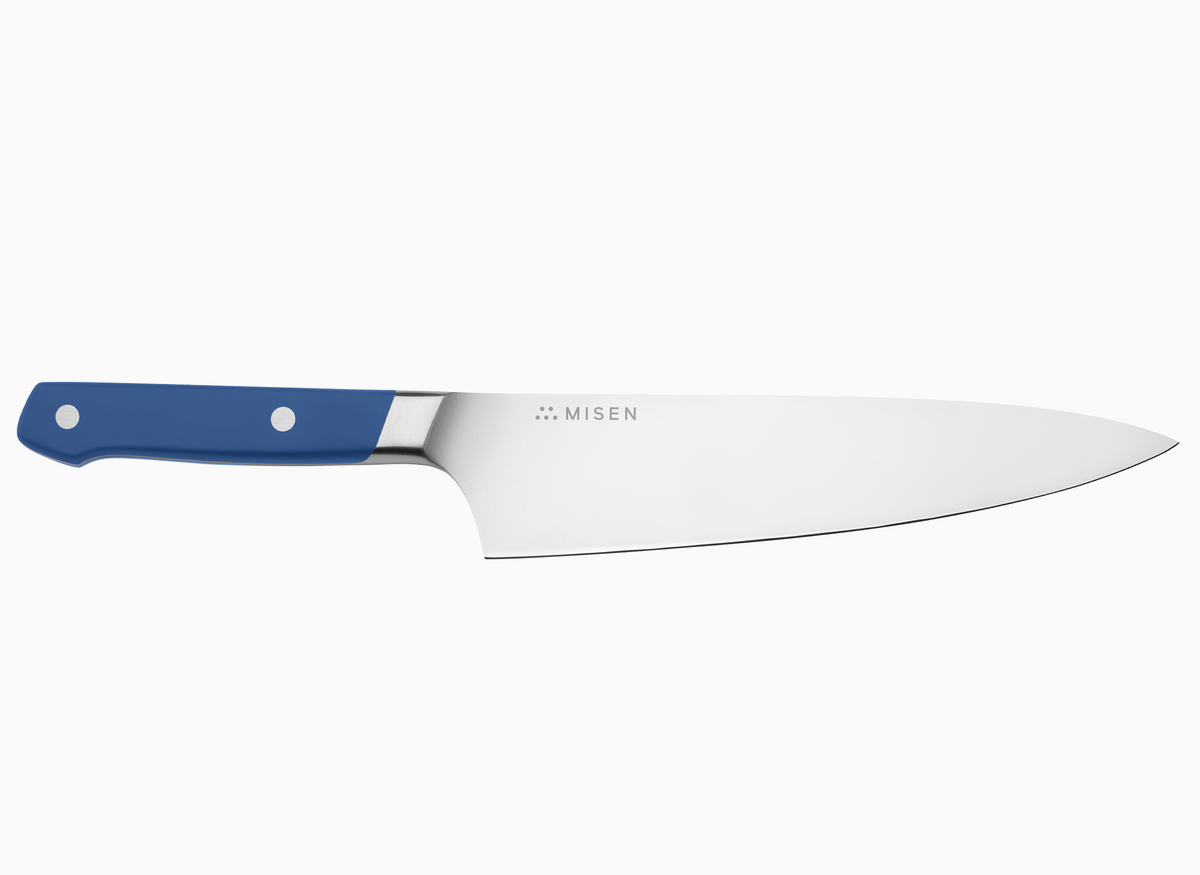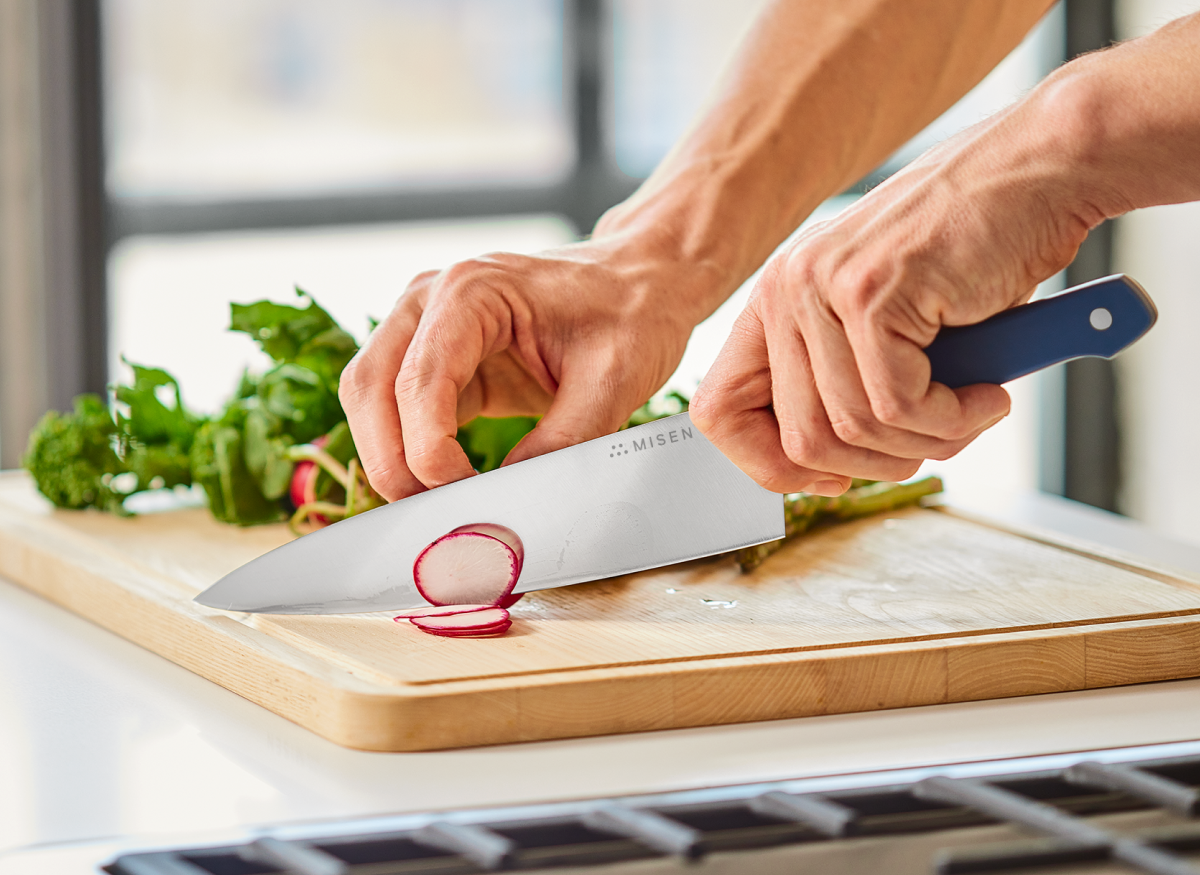Understanding Serrated Knives: From Bread to Beyond

Introduction to Serrated Knives
Definition and Unique Features
Serrated knives stand out in any kitchen arsenal with their distinctive saw-like edge. This unique design, featuring a series of sharp, tooth-like protrusions along the blade, allows for enhanced cutting performance on various materials. The serrated edge creates multiple pressure points that concentrate cutting force, enabling the knife to grip and slice through challenging surfaces with ease.
The principles of durability and versatility seen in high-quality knife steel apply to serrated blades as well. These knives often incorporate sturdy materials that resist corrosion and maintain their sharpness over extended periods, ensuring longevity and consistent performance[1]. This unique geometry makes serrated knives particularly effective for tasks such as cutting bread, slicing tomatoes, or sawing through tough materials like rope or cardboard, where a straight-edged blade might struggle or require more force.
Anatomy of a Serrated Blade
The anatomy of a serrated blade is distinct from that of a straight-edged knife, with several key components contributing to its unique functionality:
- Blade: Features a series of tooth-like protrusions along its edge, creating a saw-like appearance.
- Serrations: Typically angled and sharpened on one side, allowing for a more aggressive cutting action.
- Tip: Often pointed, facilitating precise cuts and initiating slices through tough exteriors.
- Belly or cutting edge: The workhorse of the knife, designed to grip and tear through materials with minimal pressure.
- Spine: Opposite the serrated edge, provides stability and can be used for applying additional force when needed.
- Heel: Closest to the handle, it's the strongest part of the blade and ideal for tackling particularly resistant materials.
Many serrated knives also feature a full tang, extending into the handle for improved balance and durability, enhancing the knife's overall performance in tasks ranging from slicing bread to cutting through rope[2].
Comparison with Straight-Edge Knives
Serrated knives offer distinct advantages over straight-edge knives in specific cutting scenarios. The saw-like teeth of serrated blades excel at slicing through materials with tough exteriors and softer interiors, such as bread, tomatoes, and rope. These blades maintain their cutting effectiveness for longer periods due to the multiple cutting surfaces provided by the serrations[3].
Conversely, straight-edge knives are more versatile for everyday tasks, providing cleaner cuts and greater precision for push-cutting actions. They are also easier to sharpen and maintain, making them ideal for general-purpose use[4].
The choice between serrated and straight-edge knives ultimately depends on the intended use. Serrated blades are superior for slice cuts, where a back-and-forth motion is required, while straight edges excel in push cuts and tasks demanding high precision[5].
Primary Uses of Serrated Knives
Slicing Bread and Baked Goods
Serrated knives excel at slicing bread and baked goods due to their unique saw-like edge. The serrations create a series of pressure points that grip and slice through crusty exteriors without compressing soft interiors[6]. When cutting bread, maintain a vertical knife position for even slices from top to bottom. The bread knife's versatility extends beyond loaves - it effortlessly handles delicate pastries, bagels, and even loaded sandwiches.
For optimal performance, seek a knife with wider, scalloped serrations, which create fewer crumbs while slicing. Longer blades, typically 9-10 inches, offer greater versatility for tackling large artisan loaves and specialty breads filled with extras like olives or raisins[7]. The key to using a bread knife effectively is to let the serrations do the work - draw the knife smoothly back and forth through the food without applying downward pressure.
Cutting Through Tough-Skinned Fruits and Vegetables
Serrated knives are indispensable tools in the kitchen, especially when it comes to cutting through tough-skinned fruits and vegetables. The saw-like edge of these knives allows them to grip and slice through the firm exteriors of produce like tomatoes, watermelons, and squash with ease.
For tomatoes, a serrated knife's ability to cleanly slice through the skin without crushing the delicate flesh is unparalleled. When tackling larger produce like watermelons or butternut squash, a longer serrated blade proves invaluable. Its length and sharp, pointed serrations can easily penetrate and slice through thick rinds and tough exteriors[8].
The versatility of serrated knives extends beyond just slicing; they can also be used for peeling citrus fruits or prepping pineapples, tasks that benefit from the knife's ability to grip and cut through fibrous materials without slipping[9].
Carving Roasted Meats
While serrated knives excel in many tasks, they are not typically the best choice for carving roasted meats. For this purpose, a specialized carving knife is more appropriate. Carving knives feature long, narrow blades that taper to a sharp point, making them ideal for navigating around bones and cartilage in roasted poultry or bone-in roasts.
When carving roasted meats, the length of the blade (usually 9-10 inches) allows for smooth, even slices without sawing or tearing the meat. For boneless roasts, a slicing knife with a longer blade (10-12 inches) and a rounded tip is often preferred. These knives can produce razor-thin slices from tender cuts of meat.
The key to effective carving is to let the knife do the work, using long, smooth strokes rather than a sawing motion. For those who frequently host large gatherings, investing in a high-quality carving or slicing knife can significantly improve the presentation and enjoyment of roasted meats.
Specialized Applications of Serrated Knives
Use in Food Preparation and Garnishing
Serrated knives play a crucial role in food preparation and garnishing, offering unique advantages that elevate culinary processes. These versatile tools excel at creating precise, decorative cuts for fruits and vegetables, enhancing both presentation and flavor release. The saw-toothed edge allows for intricate designs when carving melons or creating citrus twists, adding visual appeal to dishes and cocktails.
In professional kitchens, serrated knives are indispensable for efficiently preparing large quantities of sandwiches, ensuring clean cuts through various layers without crushing delicate ingredients. Their ability to grip and slice through fibrous vegetables like celery and asparagus makes them ideal for creating uniform pieces for crudités platters or stir-fries.
Additionally, serrated knives prove invaluable when working with delicate pastries and cakes, allowing chefs to achieve clean, even slices without compressing the soft interiors. This precision is particularly beneficial for businesses in the catering and food service industries, where presentation is paramount.
Applications in Outdoor and Camping Settings
Serrated knives play a crucial role in outdoor and camping settings, offering unique advantages for specific tasks. Their saw-like edge excels at slicing through tough, fibrous materials such as rope, webbing, and nylon straps, making them invaluable for setting up camp or handling emergency situations[10].
While not ideal as a primary wilderness blade due to limitations in carving and chopping, serrated knives are particularly effective in marine survival scenarios where cutting lines and slicing open fish are primary concerns. The increased surface area of serrated edges allows them to maintain their cutting effectiveness for longer periods, reducing the need for frequent sharpening in the field[11].
However, it's important to note that serrated blades can be more challenging to sharpen in wilderness settings, often requiring specialized tools like tapered diamond or ceramic rods. For this reason, many outdoor enthusiasts opt for a combination of a plain-edge primary knife and a smaller serrated blade or multi-tool for versatility[12].
When selecting a serrated knife for outdoor use, consider factors such as blade length, handle ergonomics, and sheath quality to ensure it meets the specific demands of your wilderness activities.
Utility Purposes Beyond the Kitchen
Serrated knives possess a range of utility purposes beyond the kitchen, showcasing their versatility in various settings. In outdoor and camping scenarios, these knives excel at cutting through tough, fibrous materials like rope, webbing, and nylon straps, making them invaluable for setting up camp or handling emergency situations[13].
The saw-like edge of serrated knives proves particularly effective in marine environments, where cutting lines and slicing open fish are primary concerns. Their ability to maintain cutting effectiveness for extended periods due to increased surface area reduces the need for frequent sharpening in the field.
In DIY and crafting projects, serrated knives can be employed for precise cutting of materials such as cardboard, foam board, and thin plastics, offering clean and controlled cuts that straight-edge knives might struggle to achieve. Additionally, these knives find applications in gardening, where they can be used for pruning small branches or cutting through fibrous plant stems with ease. The unique edge design allows for a controlled sawing motion that minimizes damage to surrounding plant tissue.
In the realm of home improvement, serrated knives can be utilized for scoring drywall or cutting through insulation materials, providing a cleaner cut than standard utility knives in certain situations[14].
Techniques for Using Serrated Knives Effectively
Proper Grip and Cutting Motion
Mastering the proper grip and cutting motion is crucial for effectively using serrated knives. The chef's grip, favored by professionals, involves choking up on the handle with the palm while gripping the top of the blade with the thumb and index finger. This technique maximizes the knife's weight, blade sharpness, and arm strength for efficient cutting[15].
Alternatively, the handshake grip wraps the entire hand around the handle, offering strength at the expense of precision. When cutting, employ the 'bear claw' technique with your helping hand, curling fingertips under and using knuckles to stabilize the ingredient. This method ensures safety and control while slicing.
For serrated knives, utilize a smooth back-and-forth sawing motion, allowing the blade's teeth to do the work without applying excessive downward pressure. This technique is particularly effective when cutting through crusty bread or tough-skinned produce. To maintain stability, create a flat surface on round ingredients by slicing off a thin piece, preventing wobbling and potential accidents[16].
By combining these grip and motion techniques, you'll enhance your control, efficiency, and safety when using serrated knives for various culinary tasks.
Adapting Pressure for Different Food Textures
Adapting pressure for different food textures is crucial when using a serrated knife effectively. For crusty bread, apply gentle pressure and let the serrated edge do the work, using a smooth sawing motion to slice through without crushing the soft interior[17].
When cutting through soft fruits like tomatoes or delicate pastries, use minimal downward force to prevent squishing or tearing the food. The serrated edge grips the skin or crust, allowing for clean cuts with little pressure[18].
For tougher-skinned fruits and vegetables like pineapples or eggplants, increase the pressure slightly while maintaining a gentle sawing motion to allow the serrations to grip and cut through the tough exterior. When slicing cooked meats, apply moderate, consistent pressure to achieve uniform slices without tearing the tender texture[19].
By adjusting the pressure based on the food's texture, you can maximize the serrated knife's effectiveness and achieve optimal results across a wide range of culinary tasks.
Safety Considerations When Handling Serrated Knives
When handling serrated knives, safety should be paramount. Always use a sharp knife, as dull blades require more force and increase the risk of slipping. Choose the appropriate knife for each task, considering blade size, flexibility, and edge type. Maintain proper grip and cutting techniques, such as the chef's grip or handshake grip, and employ the 'bear claw' method to protect your fingers.
Adapt pressure based on food textures, using gentle force for soft items and slightly increased pressure for tougher exteriors. Carry knives with the blade pointed downward and angled away from your body. Never attempt to catch a falling knife, and avoid leaving blades unattended.
Clean knives immediately after use, washing by hand while holding the handle. Store knives safely in designated spaces like knife blocks, racks, or magnetic holders. When cutting round fruits or vegetables, create a flat surface to prevent rolling. For challenging foods like avocados, place them on a flat surface and cut away from yourself.
Consider using specialized tools, such as pumpkin carving kits, for intricate tasks. Always keep knives out of children's reach and teach proper safety techniques when appropriate. In case of injury, apply direct pressure to minor cuts and seek medical attention for deep wounds or persistent bleeding[20].
Maintenance and Care of Serrated Knives
Cleaning and Storage Best Practices
Proper cleaning and storage of serrated knives are crucial for maintaining their sharpness and longevity. For enameled cast iron Dutch ovens, a gentle approach is key. After use, allow the pot to cool before filling it with hot water, dish soap, and baking soda. Let it soak for 15 minutes, then scrub with a non-abrasive sponge or dish scrubber[21].
For stubborn stains, create a paste using baking soda and water, apply it to the affected areas, and let it sit overnight before scrubbing[22]. To tackle exterior stains, a paste of baking soda and water applied with a non-abrasive pad can be effective[22].
Sharpening Techniques for Serrated Blades
Sharpening serrated knives requires specialized techniques due to their unique blade design. Unlike straight-edge knives, serrated blades are sharpened only on the beveled side, typically using a tapered sharpening rod or a specialized electric sharpener. The process involves carefully honing each individual serration, maintaining the original angle of the blade.
For optimal results, choose a sharpening rod that matches the size of the knife's gullets. Begin by identifying the beveled edge and determining the correct sharpening angle, usually around 20 degrees. Gently work the rod through each serration, using light pressure to avoid over-sharpening. After sharpening, remove any burrs with a fine-grit stone or leather strop.
It's crucial to avoid common mistakes such as sharpening the flat side of the blade or using inappropriate tools like flat files. For those less confident in their sharpening skills, professional services are available, including mail-in options from some knife manufacturers.
Regular maintenance, such as proper storage and hand-washing, can significantly extend the time between sharpenings, as serrated knives typically retain their edge longer than straight-edge counterparts.
Signs of Wear and When to Replace a Serrated Knife
Recognizing signs of wear in serrated knives is crucial for maintaining their effectiveness and safety. Unlike straight-edge blades, serrated knives often retain their functionality even as they dull, making it challenging to identify when replacement is necessary. Key indicators of wear include visible chips or breaks in the serrations, difficulty cutting through foods that were once easily sliced, and an increase in the force required to initiate cuts.
As serrated knives rely on their scalloped edge to grip and slice through tough exteriors, any flattening or rounding of these points significantly impairs performance. When the knife struggles to cleanly cut through bread crusts or tomato skins without crushing the interior, it's a clear sign that the blade has lost its edge.
Additionally, if the gullets between serrations appear shallower or less defined, the knife's ability to smoothly glide through food diminishes. While professional sharpening can often restore a serrated blade's effectiveness, there comes a point where replacement becomes the more practical option. This is typically when multiple serrations are damaged beyond repair or when the blade has been resharpened so many times that its overall shape and functionality are compromised.
Investing in a new serrated knife ensures optimal performance and safety in the kitchen, particularly for tasks that rely on the unique cutting action of these specialized blades.
Conclusion
Serrated knives are versatile tools that excel in a variety of kitchen tasks, from slicing bread to cutting through tough-skinned produce. Their unique design allows for efficient cutting with minimal pressure, making them indispensable for both home cooks and professional chefs. By understanding the proper techniques for using and maintaining serrated knives, you can significantly enhance your culinary experience and efficiency in the kitchen.
For those looking to expand their kitchen arsenal, consider our carbon steel wok, which offers exceptional heat distribution and versatility for a wide range of cooking techniques. Whether you're searing, stir-frying, or deep-frying, this wok can handle it all with ease.
Ready to elevate your cooking game with high-quality kitchen tools? Shop Now and discover our full range of premium cookware and knives designed to enhance your culinary experience.
- Serrated knives excel at cutting through foods with tough exteriors and soft interiors, making them ideal for bread, tomatoes, and other challenging ingredients.
- The unique saw-like edge of serrated knives allows for efficient cutting with minimal pressure, reducing the risk of crushing delicate foods.
- Proper grip and cutting motion are crucial for effectively using serrated knives, with a smooth back-and-forth sawing motion being most effective.
- Regular maintenance, including proper cleaning, storage, and occasional sharpening, can significantly extend the life of your serrated knife.
- While versatile, serrated knives are not ideal for all tasks; understanding their strengths and limitations can help you choose the right knife for each culinary job.
- Alibaba. (n.d.). Chisel Knife Steel.
- Quora. (n.d.). What is a serrated knife used for?
- KnifeArt. (n.d.). Plain Edge vs. Serrated Edge Knives.
- Everyday Carry. (n.d.). What's Better for EDC: Plain vs. Serrated vs. Combo Knives?
- Knife Depot. (n.d.). Serrated Edge vs. Straight Edge: Which Do You Prefer?
- Epicurious. (n.d.). Double-Serrated Bread Knives Are the Best Thing Since Sliced Bread.
- Serious Eats. (n.d.). The Best Bread Knives.
- The New York Times Wirecutter. (n.d.). The Best Serrated Bread Knife.
- New York Magazine. (n.d.). The Best Serrated Knives, According to Experts.
- Equipped to Survive. (n.d.). Survival Knives.
- Outdoor Life. (n.d.). How to Sharpen a Serrated Knife.
- Backcountry Chronicles. (n.d.). Best Survival Knife.
- Smith's Products. (n.d.). Everything You Need to Know About Serrated Knives.
- Escoffier. (n.d.). Different Knives and the Best Uses for Each.
- The New York Times. (n.d.). Basic Knife Skills.
- Forks Over Knives. (n.d.). Knife Skills: Cutting Technique.
- Metrobi. (n.d.). What is a Serrated Knife and What is it Used For?
- Escoffier. (n.d.). Different Knives and the Best Uses for Each.
- The Tasty Bite. (n.d.). Ultimate Guide to Bread Knife Uses.
- WebstaurantStore. (n.d.). Knife Safety Tips.
- American Cleaning Institute. (n.d.). Cleaning Knives & Cutting Boards.
- Soho Knives. (2014). Knife Cleaning.








